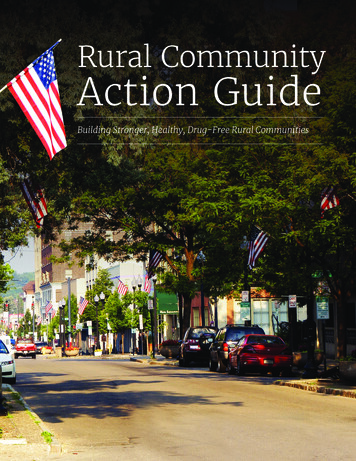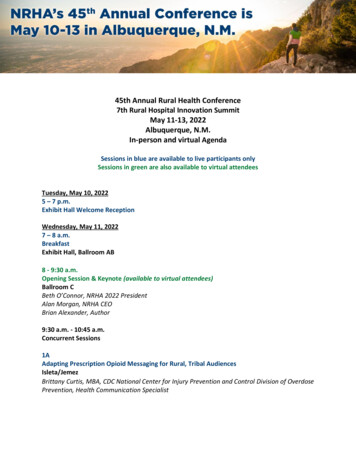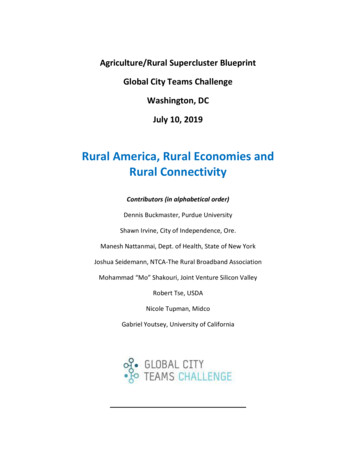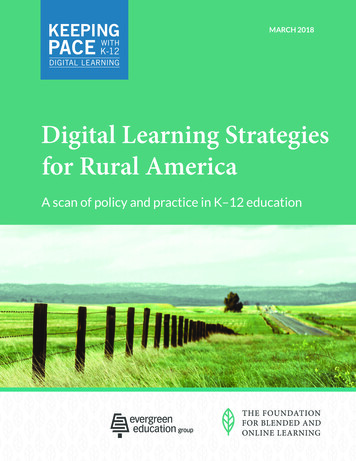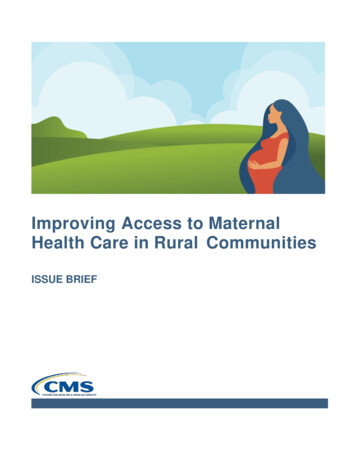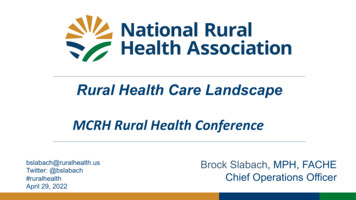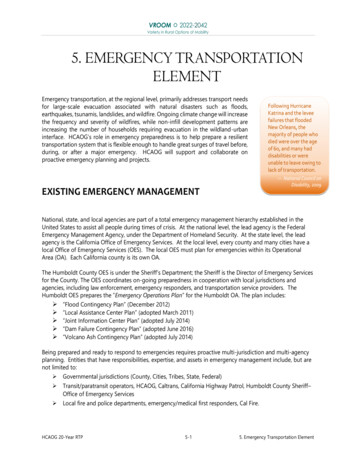
Transcription
VROOM 2022-2042Variety in Rural Options of Mobility5. EMERGENCY TRANSPORTATIONELEMENTEmergency transportation, at the regional level, primarily addresses transport needsfor large-scale evacuation associated with natural disasters such as floods,earthquakes, tsunamis, landslides, and wildfire. Ongoing climate change will increasethe frequency and severity of wildfires, while non-infill development patterns areincreasing the number of households requiring evacuation in the wildland-urbaninterface. HCAOG’s role in emergency preparedness is to help prepare a resilienttransportation system that is flexible enough to handle great surges of travel before,during, or after a major emergency. HCAOG will support and collaborate onproactive emergency planning and projects.EXISTING EMERGENCY MANAGEMENTNational, state, and local agencies are part of a total emergency management hierarchy established in theUnited States to assist all people during times of crisis. At the national level, the lead agency is the FederalEmergency Management Agency, under the Department of Homeland Security. At the state level, the leadagency is the California Office of Emergency Services. At the local level, every county and many cities have alocal Office of Emergency Services (OES). The local OES must plan for emergencies within its OperationalArea (OA). Each California county is its own OA.The Humboldt County OES is under the Sheriff’s Department; the Sheriff is the Director of Emergency Servicesfor the County. The OES coordinates on-going preparedness in cooperation with local jurisdictions andagencies, including law enforcement, emergency responders, and transportation service providers. TheHumboldt OES prepares the “Emergency Operations Plan” for the Humboldt OA. The plan includes: “Flood Contingency Plan” (December 2012) “Local Assistance Center Plan” (adopted March 2011) “Joint Information Center Plan” (adopted July 2014) “Dam Failure Contingency Plan” (adopted June 2016) “Volcano Ash Contingency Plan” (adopted July 2014)Being prepared and ready to respond to emergencies requires proactive multi-jurisdiction and multi-agencyplanning. Entities that have responsibilities, expertise, and assets in emergency management include, but arenot limited to: Governmental jurisdictions (County, Cities, Tribes, State, Federal) Transit/paratransit operators, HCAOG, Caltrans, California Highway Patrol, Humboldt County Sheriff–Office of Emergency Services Local fire and police departments, emergency/medical first responders, Cal Fire.HCAOG 20-Year RTP5-15. Emergency Transportation Element
VROOM 2022-2042Variety in Rural Options of Mobility Representatives and stakeholders for people with disabilities, seniors, people with special mobilityneeds, and transit-dependent populations. Institutions with large facilities or campuses (which may serve as emergency shelters, staging areas,etc., e.g. fairgrounds, college campuses, community centers).EMERGENCY AND RESILIENCE PLANNINGIn this section we briefly outline three standard components (or phases) of emergency planning: Emergency Preparedness Planning Emergency Response Disaster RecoveryEMERGENCY PREPAREDNESS PLANNINGProactively preparing for emergencies will lessen a disaster’s impact on the community. Proactive planningactions include assessing potential threats and vulnerabilities, establishing (or reinforcing) authorities andresponsibilities for emergency actions, acquiring and maintaining emergency resources, training emergencypersonnel, and developing and testing emergency procedures. Below we discuss these preparednessstrategies:o Alerts & Warning Messageso Asset Inventorieso Evacuation Planningo RegistriesAlerts & Warning MessagesWarning messages will alert people to an impending risk and can tell people how to take protective action. Afast and reliable warning system is vital in emergencies, especially for conveying transportation informationduring mass evacuations. Intelligent Transportation System (ITS) technologies can help broadcast warningsand keep evacuees and emergency personnel informed. Examples of such ITS applications are road weatherand information systems, changeable message signs, satellite positioning technology (e.g., GPS for in-vehicleroute guidance), and emergency vehicle preemption (which enables first responders to preempt or extendtraffic signals and navigate congested intersections).Caltrans, with support by the FHWA, is developing “Upstate California Regional Intelligent TransportationSystems (ITS) Master Plan” for the 16 counties in the North State Super Region, which encompasses CaltransDistricts 1 (Humboldt), 2, and 3. HCAOG is on the steering committee for this plan. The ITS Plan will directhow ITS technology and equipment can be used to help provide more efficient, safe, and convenient travel inthe region. Examples of ITS technological applications include traveler information websites, satellitepositioning technology, emergency vehicle preemption, and variable message signs.HCAOG 20-Year RTP5-25. Emergency Transportation Element
VROOM 2022-2042Variety in Rural Options of MobilityAsset InventoriesFor emergency planning, agencies should be aware of regional transportation assets that can be used.Transportation assets for emergency response and evacuation. Those assets include: roadways and trails,bridges, harbors, airports, public transit, paratransit, and even parking lots. In addition to infrastructure,transportation assets include agencies, trained personnel, vehicle fleets, and communication equipment. Theregion should keep current inventories of primary and contingency transportation assets, includingemergency response fleets, transit and paratransit vehicles, governmental fleets (e.g. cities, county, tribes,harbor, airport, etc.), and transit centers. Other resources are street maps (printed and GIS), and fuel andpower sources (e.g. fueling and charging stations).In 2015-2016, HCAOG’s former Service Coordination Committee1, comprisedlargely of public transit operators, coordinated with the Humboldt County OES tobuild on the framework between transit operators and emergency planners foremergency evacuation planning. Emergency contact lists and fleet inventory lists,including passenger capacity, have been compiled with information from publictransit agencies and local schools throughout Humboldt. Contact lists includeemergency contact information, radio channels and frequencies. The fleetinventory lists fleet information including fueling station locations, and passengercapacity information including ambulatory and/or wheelchair capacity. Thisemergency evacuation planning information will facilitate efficient and expedientevacuations in the event of an emergency. Agency information will be updatedregularly with RTP cycles.Evacuation PlanningEvacuation planning is HCAOG’s opportunity and responsibility to create transportation solutions forevacuating people from a hazardous area. In collaborating with multi-agency and multi-jurisdictionalplanning efforts, HCAOG can help identify transportation resources for evacuation routes and methods ofevacuation. HCAOG can also analyze the potential transportation demand in the event of a major evacuation,particularly specialized transportation needs for those more at risk, including transportation-disadvantagedgroups.Transportation planners and emergency responders will want to know who (and how many) will be at risk ifwe must evacuate the area. People at risk include those who lack independent, reliable means oftransportation. People without their own transportation are even more vulnerable if they also lack moneyand/or have a disability that limits their mobility. Peoples’ mobility can be hindered by cognitive disorders,intellectual disabilities, reduced stamina or being easily fatigued, needing use of a mobility device (e.g.,wheelchair, cane, crutches, or walker) or medical device (e.g. oxygen tank), and people with limited or no sightor hearing.People also have different behaviors during a disaster. For instance, there are numerous decisions individualsneed to make, such as whether or not to evacuate, which route to take, which mode of transportation to use,and when to leave. Understanding how people make these decisions can help inform resilience planning.Another consideration of resilience planning is mutual aid (people helping each other) and transportation1HCAOG merged the committee with the Social Services Transportation Advisory Council in 2020-21.HCAOG 20-Year RTP5-35. Emergency Transportation Element
VROOM 2022-2042Variety in Rural Options of Mobilitynetwork companies (Uber, Lyft, etc.) to assist in meeting the transportation needs of community membersduring a disaster.Best Practices for Evacuation Planning:1. Coordinate support and logistics with federal, state, local, and regional transportation resources andemergency responders.2. Educate people on evacuation procedures, personal responsibility, and public transportation optionsfor evacuating. Encourage all individuals, employers, and agencies to have evacuation plans.23. Identify the range and number of people who may need transportation in disaster situations. Mapthose populations in relation to transportation assets, evacuation routes, and reception centers orshelters. (See “Registries” below.)4. Plan for a complex array of evacuation and transportation needs, including evacuating people withmedical or mobility equipment and service animals. Plan and train for point-to-point evacuationprocedures for a wide variety of settings: school, work, home, stores, recreational venues, highways,bridges, etc.5. Have transportation guidelines for evacuation response. Partner with first responder agency personnelto develop technical guides. Partner with health services and social service agencies for disabled,seniors, and other populations with special mobility needs.6. Have MOUs with transportation agencies and paratransit agencies for disaster evacuation.7. Directly involve people with disabilities and disability organizations, including local paratransitagencies, in evacuation planning and training exercises.RegistriesMaintaining a self-identified registry system is one way to estimate and plan for transportation demand in thecase of a major emergency. Registries identify those most at risk of losing mobility/transportation optionsduring an emergency. Registries should be up-to-date, readily available to first responders, and linked tothose involved in transportation and evacuation support.Emergency responders and other agencies may have concerns about how practical and effective registriesare. These concerns should be discussed, and a consensus sought on whether registries are workable or not,locally and regionally.2“Employers are subject to meeting ADA provisions and must address the needs of people with disabilities in evacuation plans (Loy and Batiste,2004). Such provisions may be limited to designating a temporary location of refuge while waiting for rescue or could include buddy systemsfor helping people out of buildings.” (NCD 2009)HCAOG 20-Year RTP5-45. Emergency Transportation Element
VROOM 2022-2042Variety in Rural Options of MobilityRecommendations for Building a Resilient Transportation SystemIdentify VulnerabilitiesIdentify where and how a system’s components could fail or become inefficient. Examples of potentialproblems are: A transportation link breaks, such as a blocked roadway, bridge, or sidewalk. A disaster causes extreme traffic congestion on a particular roadway(s). A disaster requires emergency transport of a large number of people, many who cannot drive, havedifficulty walking, or have medical problems that limit their mobility.Identify Ways to Increase Resilience and SecurityExamples of strategies that can increase resilience are: Increase transportation system diversity. Maintain opportunities for people to walk, cycle, rideshare,carshare and travel by transit. Increase network redundancy and connectivity (e.g., the number of roads and transit routes in an area). Increase facility design and construction standards to withstand extreme conditions. Improve the ability to communicate with transportation system users, including people with specialneeds, even under unusual conditions. Establish ways to prioritize transportation system resources (road space, fuel, vehicle capacity) so it isavailable first to higher-value transportation activities.Source: Victoria Transport Policy Institute, British Columbia, CanadaEMERGENCY RESPONSETransportation and EvacuationTransit and paratransit fleets can serve as emergency vehicles for evacuating people, as can aircraft. Localparatransit and transit resources are some of the best assets to tap into for evacuating people with mobilitydisabilities because the regular drivers and dispatchers are already familiar with individuals who most needtransportation assistance, and often know their needs and locations. Evacuating people with disabilitiesincludes evacuating caregivers, guardians, service animals, and necessary mobility and medical equipment(e.g., wheelchairs). Paratransit and transit agency dispatchers can also relay updates about emergency roadconditions, and can help get out warnings and alerts to regular riders.Evacuation response should account for alternative modes of travel. Households without a car may choosewalking or bicycling as their mode of transport to evacuate. Providing and maintaining an integrated multimodal transportation network is therefore critical to support evacuations.Emergency preparedness plans and formal agreements should cover how transit and paratransit resourcescan be utilized and coordinated with other emergency response efforts. For example, plans should specifywhen transit vehicles, used for emergency purposes, will have access to fire or flood zones if roads are closedto non-emergency vehicles. Mutual aid agreements (or MOUs) should describe if emergency servicespersonnel will escort transit vehicles through danger areas, or if, for instance, transit drivers must be certifiedfor emergency evacuation transport.HCAOG 20-Year RTP5-55. Emergency Transportation Element
VROOM 2022-2042Variety in Rural Options of MobilitySearch and RescueTransportation resources can aid in search and rescue efforts after a major disaster.Transit and paratransit vehicles can help transport the seriously injured to localmedical facilities, and airplanes and helicopters can provide emergency medicalevacuation to hospitals further away. Buses, vans, and aircraft can also transportsearch-and-rescue teams into the affected areas, and airports provides takeoff andlanding areas for search-and-rescue flights. Fleet vehicles can assist in animal (pet)search and rescue as well.DISASTER RECOVERYFew communities develop disaster recovery plans before a disaster strikes (the Cityof Los Angeles is a notable exception) (NCD, 2009). The recovery phase includeswork to restore public services and safety, clean up damaged areas, and get peopleback to their homes, schools, and workplaces as quickly as possible.One of the first tasks for recovery is to assess damage to major infrastructure. Agencies in each affectedjurisdiction must examine the impact on the transportation system and other public facilities. The postdisaster inventory of transportation assets will allow responders to prioritize needs, assign resources, andappeal for outside aid.GOALS, OBJECTIVES, & POLICIESG O A L : Humboldt County has a transportation system that will successfully serve its population in theevent of a major disaster, hazard, or emergency, thereby mitigating the potential medical, financial,and emotional traumas to the community.O B J E C TI V E S : To strive for this goal, HCAOG shall support policies that help achieve the RTP’s mainobjectives/planning priorities (in alphabetical order):3The tree symbol indicates objectives that are Safe & Sustainable Transportation objectives (see Chapter2 for all SST objectives and targets.)MAINOBJECTIVES:ActiveTransportationMode Share/Complete Streets3EMERGENCY TRANSPORTATION SUB-OBJECTIVES ( ) AND POLICIES Pursue Complete Streets to give people more transportation options in emergencyevacuations.The objectives are described in more detail in Chapter 2, Renewing Our Communities.HCAOG 20-Year RTP5-65. Emergency Transportation Element
VROOM 2022-2042Variety in Rural Options of MobilityEconomicVitalityEfficient p &ClimateProtectionEquitable &Sustainable Useof ResourcesSafety & Health Increase emergency transportation preparedness to help minimize the direct costs andindirect economic losses caused by major disasters, hazards, or emergencies. Improve asset and vulnerability analyses of the regional transportation system, includinginfrastructure, equipment, and trained personnel. Attain regionally coordinated, multi-modal planning for emergency preparedness,evacuation, search and rescue, and recovery.Policy Emergency-1 HCAOG will support and collaborate in reviewing and updating emergencyplans to address transportation resources available in all phases of disasters: prevention,preparedness, response, recovery, and mitigation. Reduce on-road transportation-related fossil fuel consumption in Humboldt County.Policy Emergency-2 HCAOG will lead, facilitate, and support efforts to incorporate climatechange adaptation and resiliency planning into emergency transportation and evacuationplanning. Increase the equitable distribution of county residents who live in homes/apartments/dorms where they can safely, comfortably, and conveniently travel toshelter areas and emergency services by a variety of modes.Policy Emergency-3 HCAOG will facilitate and encourage involving people with disabilities anddisability organizations, and other transportation-vulnerable stakeholders, in emergencyplanning, including assessments, exercises, training, debriefing, and post-action reports. Improve the emergency preparedness and resilience of transportation facilities. Keep transportation systems, agencies, and personnel ready and equipped to seamlesslyexecute emergency response transportation operations.Policy Emergency-4 HCAOG supports region-wide, multi-agency planning, training, andequipment acquisition for emergency preparedness and resiliency. HCAOG and the publictransit operators should work with the County Office of Emergency Services to develop acollaborative, effective role in disaster preparedness and response.Policy Emergency-5 HCAOG will help disseminate emergency preparedness information andeducational materials on emergency transportation and emergency evacuation.ACTION PLAN: PROPOSED PROJECTSTo work towards achieving our objectives for emergency transportation, HCAOG staff and committees willcontinue to establish and maintain contacts for collaborating and participating with other stakeholders. HCAOGdoes not intend to “recreate the wheel” where emergency plans already exist. We intend to work fromemergency plans and strategies already established, and help develop, augment, or improve transportationrelated procedures.Table Emergency-1 Regional Emergency Transportation Proposed ProjectsInteragency Emergency Transportation Planning ProjectAgencyHCAOG,SSTACPlanning Framework — Foremost through the SSTAC, explore opportunities tocreate a formal framework between transit operators and emergency planners.The framework may identify, establish, and standardize information-sharingbetween transit agencies and emergency operations centers (EOCs). ProjectsHCAOG 20-Year RTP5-7FundingSourceRPA, LTF,grantsST orLT*ST5. Emergency Transportation Element
VROOM 2022-2042Variety in Rural Options of Mobilitycould also address improving communications and leadership between theagencies and training within transit agencies.HCAOG,SSTACHCAOG,SSTACTransportation Guidelines for Evacuation Response (for public transit operators)— As needed, participate in developing regional guidelines for how local publictransit operators’ will function in emergency evacuation situations. Coordinatewith first responder agency personnel to develop public transit operatortechnical guidelines for use in emergency evacuations. Coordinate with firstresponder agency personnel and health services and social service agencies fordisabled seniors, and other populations with special mobility needs.Registry—Explore if a registry of populations with mobility limitations would beworthwhile as a resource for local transit and public health/social serviceproviders. If so, identify the geographic range and number of people who mayneed transportation in disaster situations. Map the populations in relation totransportation assets, evacuation routes, and reception centers or shelters.RPA, LTF,grantsSTRPA, LTF,grantsST*Short-term (ST) is one to 10 years, long-term (LT) is 10 to 20 yearsFUNDINGMost transit operators are not currently in a position to fund emergency planning exercises and programs fromtheir operating budgets. Money for emergency planning, exercise planning, and training often must come fromgrants and other governmental sources. Potential federal and state resources include training classes (offeredby the California OES, U.S. DOT, U.S. FTA) on incident management systems and terrorism awareness. The U.S.Department of Homeland Security and the California Office of Homeland Security administer several grantprograms also.HCAOG 20-Year RTP5-85. Emergency Transportation Element
VROOM 2022-2042Variety in Rural Options of MobilityPERFORMANCE INDICATORSThe table below, lists performance indicators for an emergency transportation system. The table groups indicators by “goals,” which correspond to theRTP’s six main objectives/planning priorities.Table Emergency-2 Performance Indicators for Emergency Transportation OperationsGOALSINDICATORSMEASURESDATA SOURCESBalanced ModeSharesHas access increased for transit, paratransit,micro-transit, walking and/or biking foremergency evacuation?Efficient & ViableTransportationSystemHas HCAOG participated in more emergencyplanning and/or collaborated on moreemergency plans?Are inventories current for emergencytransportation assets?EnvironmentalStewardshipDo emergency plans include or coordinate withefforts to adapt to and mitigate climate changeimpacts?Equitable &Sustainable Use ofResourcesHave members of the most vulnerable Number of people from vulnerable populations whopopulations (disabled, elderly, people withoutactively participated in emergency drills and/or otherprivate means of transport) participated inemergency planning efforts.emergency planning efforts?Are emergency evacuation resources adequate? Number of safety improvement projects implemented.Are redundancies in place in case primary Public-assisted emergency evacuations per 1,000 residents.communication systems or response resources Average rate of response and/or miles of transport forare disrupted?publicly assisted emergency evacuees. Number of emergency evacuations unfulfilled or denied.Safety & PublicHealthHCAOG 20-Year RTP Major, essential emergency destinations lacking safeaccess by transit/paratransit/micro-transit and/or walkingand biking. Plans developed/updated with HCAOG input. Rate at which plans and inventories are updated.Local transit operators’ data. Emergency plans lacking actionable measures to preparefor and respond to anticipated impacts related to climatechange.Emergency plans, agreements,protocols, and assetinventories. Climate changeplans.5-9Emergency plans, agreements(MOU, MOA), protocols, andasset inventories.Emergency plans, agreements(MOU, MOA), protocols, andasset inventories.Reports on emergencytests/drills. Post-emergencydata.8. Emergency Transportation Element
VROOM 2022-2042Variety in Rural Options of MobilityREFERENCESCITATIONSLitman, Todd 2006 Lessons from Katrina and Rita: What major disasters can teach transportation planners. Victoria TransportPolicy Institute. British Columbia, Canada. (April 13, 2006) (www.vtpi.org/katrina.pdf, accessed December 2012.)NARC 2009 (National Association of Regional Councils, U.S. Department of Transportation-Federal Highway Administration)Streamlining Cross-Linking Transportation and Evacuation Planning: A Resource Guide for MPOs and Regional Councils.(September 2009) onresourceguide final.pdf, accessed December 2012.)NCD 2008 (National Council on Disability) National Council on Disability Quarterly Meeting, New Orleans. (January 2008)NCD 2009 Effective Emergency Management: Making Improvement for Communities and People with Disabilities. (August 2009)SACOG 2008 (Sacramento Association of Governments) Rural-Urban Connections Strategy Wiki, Transportation WorkingPaper,” Section 4-Transportation Safety and Security in Rural Areas, circa 2008.(www.sacog.org/rucs/wiki/index.php/Emergency Response, accessed January 2013.)Victoria Transport Policy Institute 2012 (British Columbia, Canada) TDM Encyclopedia. (www.vtpi.org/tdm/tdm88.htm(accessed December 2012.)RESOURCESFederal Emergency Management Agency–U.S. Department of Homeland Security 1996 Guide for All Hazard EmergencyOperations Planning, State and Local Guide 101. (September 1996) (www.fema.gov/pdf/plan/slg101.pdf)Federal Emergency Management Agency–U.S. Department of Homeland Security 2007 Robert T. Stafford Disaster Reliefand Emergency Assistance Act,” FEMA 592. (June amended)Humboldt County Sheriff’s Department, Office of Emergency Services 2002 County of Humboldt Emergency OperationsPlan–Humboldt Operational Area. (June 2002)Kittelson. “Emergency Evacuation Strategies for Every Community,” ngprinciples-for-every-community/ Accessed May 21, 2021).National Consortium on the Coordination of Human Services Transportation 2006 Transportation and EmergencyPreparedness Checklist. (2006) lefiles/Emergency Checklist.pdf)HCAOG 20-Year RTP5-105. Emergency Transportation Element
agencies, in evacuation planning and training exercises. Registries Maintaining a self-identified registry system is one way to estimate and plan for transportation demand in the case of a major emergency. Registries identify those most at risk of losing mobility/transportation options during an emergency.
